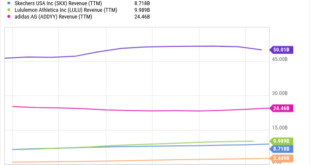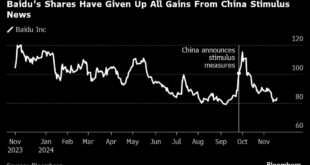(Bloomberg) — Warehouses across China are bulging with grain as a deepening economic crisis takes hold, leaving the world’s farmers to grapple with the prospect of a long-lasting slowdown gripping one of their largest customers.
Most Read from Bloomberg
The strain across global markets is already showing. French barley exports to China have been tumbling and the US has yet to sell a full corn cargo for the new season. Wheat farmers in Australia are likely to be nervous as they prepare to start harvesting their new crop over the coming weeks.
None of this will change soon, and the combination of an aging population and a cooling economy augurs poorly for the future. Traders and farmers will need to start adjusting to a very different demand outlook. Even if food security concerns keep imports robust for years to come, the meteoritic growth seen through the past two decades is likely over.
“People are getting more pessimistic about the economy and demand,” said Ivy Li, a Shanghai-based commodity markets analyst at StoneX. “Importers will be very cautious, buying more slowly and doing more hand-to-mouth purchases. Impact from the collapse of confidence is all around.”
China’s slowdown and the pain in the country’s property market have battered consumer confidence, pushing money-conscious households to cut back on meat and forgo restaurants, curbing the amount of crops needed to feed a massive pig herd or to fry food.
Beijing has already taken steps to try to protect farmers, asking traders to limit overseas purchases of corn, barley and sorghum — an effort to ease oversupply exacerbated by a buying spree earlier in the year, when merchants snapped up cheap overseas cargoes. These eventually flowed to Chinese ports just as consumption softened. The nation has also moved to reduce the use of soymeal in animal feed.
Shrinking Trade
China’s economic boom at the start of the century transformed the nation into a powerhouse consumer of commodities from grain to metals and oil, and led to resource-rich countries ramping up output to meet surging demand. China’s own agriculture industry is huge, but the need to feed 1.4 billion people mean it’s become a behemoth importer of soybeans over the years — and more recently a major wheat buyer.
For the season starting in September, the US has sold only 13,400 metric tons of corn for delivery to China, compared with more than 564,000 tons a year earlier, according to US Department of Agriculture data. Over the course of 2023-24, exports were 63% lower. Shipments from Brazil also fell.
Exports of French barley — including malting that’s used to make beer — are running almost 50% lower this season from the key Rouen port compared with a year ago. Industry group Intercereales sent a delegation to China seeking clarity from customers on a recent request by authorities to limit imports.
“We are witnessing a bit of a freeze in business,” said Philippe Heusele, the president of international relations at Intercereales.
Feeding Pigs
One key commodity where China will continue to rely heavily on imports is soybeans, with Brazil and the US big winners from the trade. Its domestic output is far from being capable of meeting its needs, even if demand has slowed.
Brazil saw record exports to China earlier this year thanks to cheaper beans, used for cooking oil and animal feed for pigs. But looking ahead, the US has so far sold less than 5 million tons for delivery in the 2024-25 season — the lowest in 16 years outside of the 2018-19 trade war, and down 25% from a year ago.
“Chinese demand is not as strong as it has been in the past,” said Paulo Sousa, the president for Cargill Inc. in Brazil. “We are not seeing significant growth like in previous years.”
And local farmers are not the only ones feeling the squeeze, with profits for major catering businesses in Beijing plunging 88% over the first half of the year as consumers became more frugal.
‘Greater Scrutiny’
The outlook for the Chinese economy remains bleak, with deflation showing signs of spiraling and the nation’s annual growth target this year looking increasingly out of reach. Some in China’s agriculture industry are starting to run the numbers on what imports in 2024-25 may look like.
Overseas corn shipments could more than halve to 9 million to 11 million tons, while wheat imports may decline to around 7 million to 9 million tons — down from 13 million in 2023-24 — according to traders based in China, who asked not to be identified because they’re not authorized to speak to media.
Beijing “stated earlier this year their goal of improving incomes for Chinese grain producers and to promote increased efficiency in agriculture, which implies China will have greater scrutiny on imports in the future,” said Tanner Ehmke, lead economist for grains and oilseeds at CoBank. “But there’s also the obvious concern about China’s slowing economy.”
While foreign farmers and traders will likely see profits shrink, the upside for global consumers is that cheaper grain could ease pressure on food inflation that surged after the invasion of Ukraine. The other unknown heading into 2025 is the outcome of the US presidential election in November, which could upend trade flows should the winner take a tough stance on China.
A final question mark is the weather, which could yet hit plans to reduce overseas purchases. China was forced to feed a large portion of its wheat to animals last year after rain damage, boosting imports.
China has been the biggest buyer of Australian wheat over the past couple of years. It’s now yet another producer where some farmers are already looking elsewhere.
Farmer Andrew Weidemann usually ships around a fifth of his grain to China. He’s expecting that volume to halve. “Anything that happens in China is going to have a huge impact on the markets everywhere else,” said Weidemann, who operates a farm spanning 4,000 hectares in central Victoria in the southeast of Australia.
–With assistance from Celia Bergin, Nayla Razzouk, Gerson Freitas Jr., Clarice Couto and Isis Almeida.
Most Read from Bloomberg Businessweek
©2024 Bloomberg L.P.
Source link
 meganwoolsey Home
meganwoolsey Home

